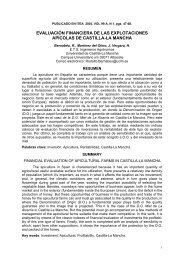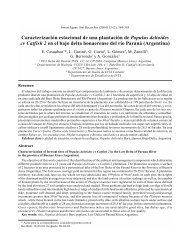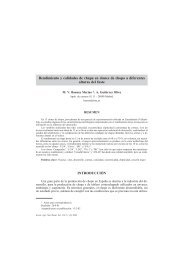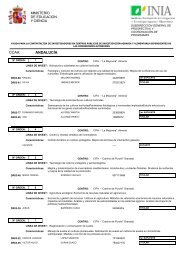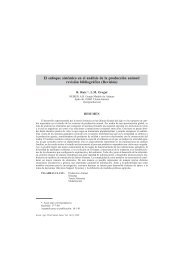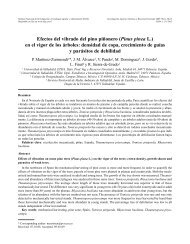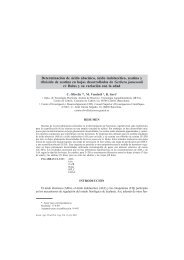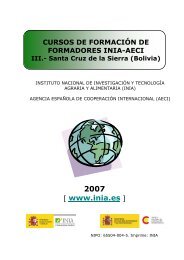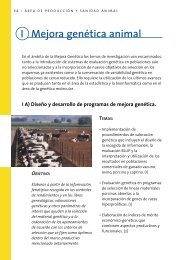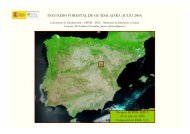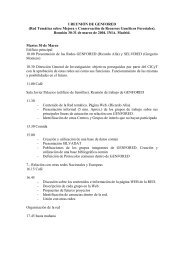Status of medicinal and aromatic plants in - Inia
Status of medicinal and aromatic plants in - Inia
Status of medicinal and aromatic plants in - Inia
You also want an ePaper? Increase the reach of your titles
YUMPU automatically turns print PDFs into web optimized ePapers that Google loves.
48<br />
WORKING GROUP ON MEDICINAL AND AROMATIC PLANTS: FIRST MEETING<br />
Regions <strong>of</strong> Hungary specialized <strong>in</strong> MAP collect<strong>in</strong>g <strong>and</strong>/or cultivation<br />
The traditional regions <strong>of</strong> utilization <strong>of</strong> the <strong>in</strong>digenous flora <strong>and</strong> the ma<strong>in</strong> cultivation areas <strong>of</strong><br />
MAPs are shown <strong>in</strong> Fig. 1.<br />
Reg 2<br />
Reg.6b<br />
Reg.3<br />
Reg.5<br />
Reg.1<br />
Reg.4<br />
Reg.6a<br />
Reg.7<br />
Fig. 1. Traditional regions for utilization <strong>of</strong> <strong>in</strong>digenous flora <strong>and</strong> ma<strong>in</strong> cultivation areas <strong>of</strong> <strong>medic<strong>in</strong>al</strong> <strong>and</strong><br />
<strong>aromatic</strong> <strong>plants</strong> <strong>in</strong> Hungary:<br />
Reg. 1 = Great Pla<strong>in</strong> <strong>and</strong> East Tisza river region<br />
Reg. 2 = North-central mounta<strong>in</strong>ous region <strong>of</strong> Hungary<br />
Reg. 3 = Balaton highl<strong>and</strong><br />
Reg. 4 = South Hungary<br />
Reg. 5 = Bakony <strong>and</strong> its surround<strong>in</strong>gs<br />
Reg. 6a = Region suitable for "spr<strong>in</strong>g poppy" cultivation<br />
Reg. 6b = Northern part <strong>of</strong> Transdanubia suitable for "autumn poppy" cultivation<br />
Reg. 7 = Region <strong>of</strong> plant species which can be cultivated all over the country<br />
• Traditional regions <strong>of</strong> utilization <strong>of</strong> the <strong>in</strong>digenous flora<br />
The regional specialization <strong>in</strong> Hungary for utilization <strong>of</strong> the <strong>in</strong>digenous flora dates back to<br />
the beg<strong>in</strong>n<strong>in</strong>gs <strong>of</strong> the 1920s. This specialization took place spontaneously <strong>in</strong> response to<br />
various biological, economical <strong>and</strong> social factors (Bernáth 1994). As a result <strong>of</strong> spontaneous<br />
specialization dur<strong>in</strong>g the past 80-90 years, well-def<strong>in</strong>ed production areas have appeared,<br />
which have had a great <strong>in</strong>fluence on the effectiveness <strong>of</strong> the <strong>medic<strong>in</strong>al</strong> plant sector <strong>in</strong> the<br />
past <strong>and</strong> may also affect its future development.<br />
- Region 1<br />
The natural occurrence <strong>of</strong> Matricaria recutita <strong>in</strong> Hungary is one <strong>of</strong> the model examples<br />
illustrat<strong>in</strong>g the regional specialization for utilization <strong>of</strong> species <strong>of</strong> the <strong>in</strong>digenous flora<br />
(Fig. 1). From a biological po<strong>in</strong>t <strong>of</strong> view, chamomile grown <strong>in</strong> sal<strong>in</strong>e habitats was regarded<br />
as high quality. This was first based on empirical observations <strong>and</strong> later confirmed by<br />
sophisticated chemical <strong>and</strong> pharmacological analysis. From a socioeconomical po<strong>in</strong>t <strong>of</strong> view<br />
the development <strong>of</strong> this region was promoted by the abundance <strong>of</strong> labour locally. Accord<strong>in</strong>g<br />
to the data <strong>of</strong> trad<strong>in</strong>g companies, as many as 15 000-20 000 people are <strong>in</strong>volved <strong>in</strong> gather<strong>in</strong>g<br />
chamomile flowers at harvest time, even today. Because <strong>of</strong> the short duration <strong>of</strong> the<br />
chamomile harvest <strong>and</strong> process<strong>in</strong>g, the regional activity had to be complemented by<br />
utilization <strong>of</strong> other MAPs <strong>in</strong>digenous to the region (Juniperus communis, Achillea millefolium,<br />
Gypsophila paniculata, Crataegus spp., Rosa spp., etc.).




